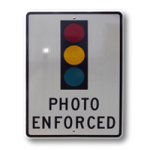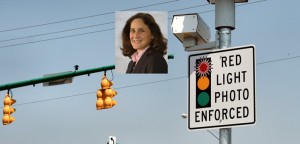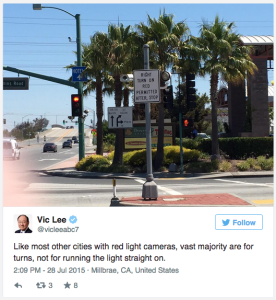Ray Huard
Run a red light and — flash — get a keepsake color snapshot, courtesy of San Diego police along with a $105 ticket.
Under a one-year pilot program approved by the City Council yesterday, special cameras will be installed within six months at 16 targeted intersections to photograph motorists who run red lights.
The snapshots will be mailed to the registered owners of cars or trucks caught cruising through the intersections under the soft glow of a traffic light that’s turned to red for stop.
If the registered owners weren’t driving when their cars or trucks were snapped, they can explain the situation by writing a note and the name of who was driving on the back of the photograph. Then they can mail it back to the city, said traffic engineer Julio Fuentes.
Those who don’t name the drivers could wind up arguing their case in court, Fuentes said.
To get their picture snapped, motorists will have to cross into the intersection after the light has turned red, said Dana King, marketing director for U.S. Public Technologies Inc., the firm that will install the cameras.
Rushing through on a yellow light won’t count, King said, even if the light changes to red when the car is partway through the intersection.
“We tend to err on the part of the driver,” King said.
For the first 30 to 60 days, those caught by the cameras will get a warning, Fuentes said.
The city has yet to decide which intersections will be equipped with the cameras, Fuentes said.
Those that have logged the highest number of accidents include:
43rd Street at El Cajon Boulevard in the Kensington/City Heights area.
Fairmount Avenue at University Avenue in City Heights.
Fairmount Avenue at Orange Avenue in City Heights.
El Cajon Boulevard at Normal Street in University Heights.
Cleveland Avenue at Washington Street in the Hillcrest/University Heights area.
Heritage Road at Otay Mesa Road in Otay Mesa.
33rd Street at El Cajon Boulevard in the Normal Heights/City Heights area.
32nd Street and Harbor Drive in Barrio Logan.
43rd Street at University Avenue in City Heights.
4th Avenue at A Street downtown.
Ash Street at Front Street downtown.
1st Avenue at A Street downtown.
5th Avenue at Cedar St. downtown.
42nd Street at University Avenue in City Heights.
16th Street at Broadway downtown.
Deep Dell Road at Paradise Valley Road in the North Bay Terraces/South Bay Terraces area.
Fashion Valley Road at Hotel Circle North in Mission Valley.
University Avenue at Winona Avenue in City Heights.
32nd Street at National Avenue in Memorial.
3rd Avenue at A Street downtown.
When an intersection is selected it will be posted with signs warning that cameras are present “so people will know what’s going on,” Fuentes said.
The theory is that when people see the signs, they won’t risk running the lights, Fuentes said.
The cameras, which cost about $50,000 each, will be installed and maintained by U.S. Public Technologies. The firm will not charge for the cameras. And if the cameras are kept for two years, there is no charge to the city for installing and maintaining them.
Instead, United Technologies will get up to $25 of the fine paid by violators. If the city cancels the program after the first-year test period, it would have to pay United Technologies $150,000.
El Cajon is installing similar cameras at five targeted intersections within the next two weeks under a pilot program run by U.S. Public Technologies, said El Cajon associate traffic engineer Trev Holman.
San Francisco and Los Angeles have also started similar pilot programs, Fuentes said.
In Los Angeles, cameras were installed at intersections along the Metrorail’s Blue Line where motorists were running both red lights and rail crossing guards, King said.
Since then, the number of accidents has dropped by 92 percent at those intersections, King said.
So far, the plan in El Cajon has prompted few complaints, aside from a few people who grumbled about having their picture taken without their permission, Holman said.
“All we’re trying to do is reduce accidents,” Holman said. About 11 percent of accidents in El Cajon are caused by people running red lights.
Fuentes said he had no firm estimate for San Diego, but 11 percent sounded low. “In some places, it ranges up to 30 percent.”



